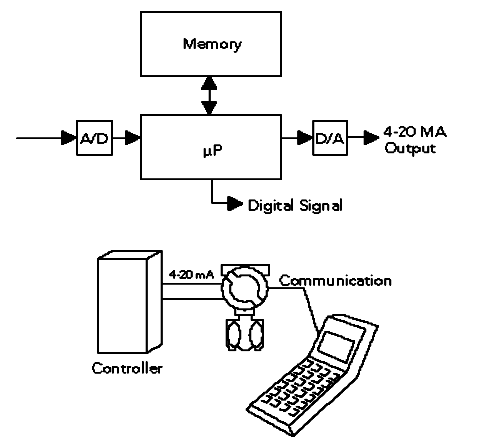A smart transmitter is a microprocessor-based transmitter that can be programmed; has a memory; can perform calculations; can perform self-diagnostics; reports faults; and can be communicated with from a remote location
Smart transmitters can convert analog signals to digital signals, making communication swift and easy, and can even send analog and digital signals at the same time.
A smart transmitter has a number of other capabilities as well. For instance, inputs can be varied, as denoted by A/D. If a temperature transmitter is a smart transmitter, it will accept millivolt signals from thermocouples, and resistance signals from RTDs and thermistors.
Components of the smart transmitter are illustrated in the lower figure. The transmitter is built into a housing, about the size of a softball, as seen in figure.

The controller takes the output signal from the transmitter and sends it back to the final control element. The communicator is shown on the right. The communicator is a hand-held interface device that allows digital “instructions” to be delivered to the smart transmitter.
Testing, configuring, and supplying or acquiring data are all accomplished through the communicator. The communicator has a display that lets the technician see the input or output information. The communicator can be connected directly to the smart transmitter, or in parallel anywhere on the loop.
CONFIGURATION
Smart transmitters can be configured to meet the demands of the process in which they are used. For example, the same transmitter can be set up to read almost any range or type of thermocouple, RTD, or thermistor; reducing the need for a large number of specific replacement devices.
RE-RANGING
The range that the smart transmitter functions under can be easily changed from a remote location, for example, by the technician in a control room. The technician or the operator has access to any smart device in the loop, and does not even have to be at the transmitter to perform the change. The operator does need to use a communicator, however.
A communicator allows the operator to interface with the smart transmitter. The communicator could be a PC, a programmable logic controller (PLC), or a hand-held device. The type of communicator depends on the manufacturer.
Re-ranging is simple with the smart transmitter; using a communicator, the operator can change from a 100 ohm RTD to a type-J thermocouple just by reprogramming the transmitter. The transmitter responds immediately and changes from measuring resistance to measuring millivoltage.
A smart transmitter will accept a wide range of inputs; for instance, with pressure units, the operator can determine ahead of time whether to use inches of water, inches of mercury, psi, bars, millibars, pascals, or kilopascals.
CHARACTERISTICS
Another characteristic of a smart transmitter is its ability to act as a stand-alone transmitter. In such a capacity, it sends the output signal to a distributed control system or a PLC.
SIGNAL CONDITIONING
Smart transmitters can also perform signal conditioning, scanning the average signal and eliminating any noise spikes. Signals can be delayed (dampened) so that the response does not fluctuate. This is especially useful with a rapidly changing process.
SELF-DIAGNOSIS
Finally, a smart transmitter can diagnose itself and report on any problems in the process. For example, it can report on a circuit board that is not working properly.
SUMMARY OF SMART TRANSMITTER BENEFITS
There are distinct advantages in using a smart transmitter. The most important include ease of installation and communication, self-diagnosis, improved and digital reliability.
Smart transmitters are less subject to effects of temperature and humidity than analog devices, and although vibration can still affect them, the effects are far less than with analog devices. Smart transmitters also provide increased accuracy, and because they can replace several different types of devices, using them allows for inventory reduction.
More info -